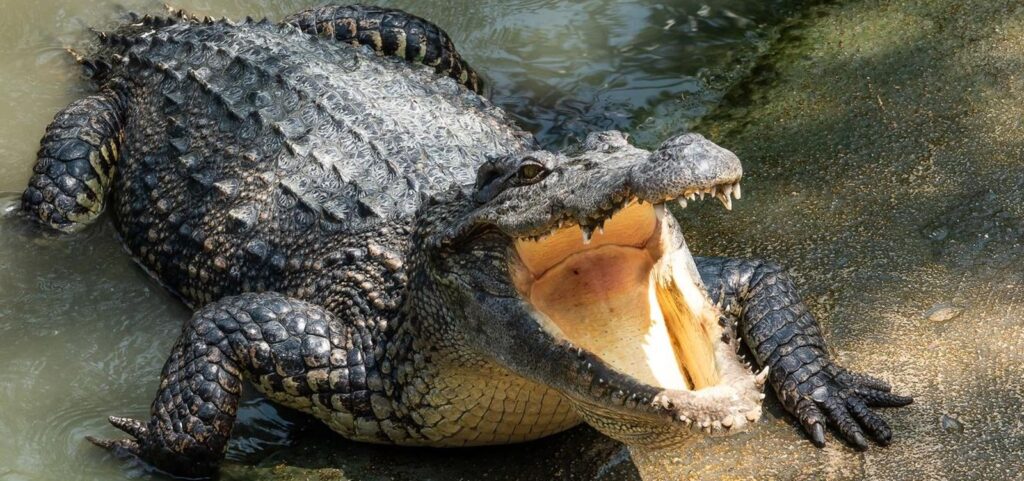3 Reasons Why Crocodiles Are As Indestructible As They Look

Crocodilians—semiaquatic reptiles comprising crocodiles, gharials, alligators and caimans—are remarkable. Often described as living fossils due to their ancient lineage, these formidable predators have roamed the Earth for over 200 million years, witnessing the rise and fall of countless species, yet their basic form has remained relatively unchanged.
Their persistence through ages speaks volumes about their evolutionary success, largely attributed to a perfect blend of anatomical and behavioral adaptations that have stood the test of time.
There are a number of videos circulating online, showcasing crocodilians enduring serious injuries yet brushing them off with astonishing indifference. As bewildering as it is amusing, this display of stoicism offers a glimpse into their extreme survival capabilities.
Here are three reasons why these animals are the perennial indestructibles of the natural world.
Reason 1: Their Almost Impenetrable Body Armor
Reptiles are known for their scales, which provide a certain level of protection and camouflage. However, crocodilians take this protective feature to the next level with the evolution of their scales into tough plates known as scutes. This is the external, visible part of the crocodilian armor, mostly made of keratin—the same strong material found in human hair.
Crocodilians are also equipped with osteoderms, which are essentially bony deposits covered by their scutes. These are reinforced with a substance called hydroxyapatite, the same material that makes human bones strong. With a porosity of around 12%, these osteoderms can absorb impacts, according to a paper on the structure of alligator armor published in Materials Science and Engineering.
The edges of these bony structures have special grooves and depressions, allowing them to interlock with each other and the surrounding skin tightly. This design plays a crucial role in distributing the force of a blow across a wider area, reducing the chance of serious injury.
Reason 2: Powerful Antioxidants In Their Blood
Crocodilians have an internal defense mechanism that’s equally impressive as their external armor. One of the secrets to their resilience lies in their blood, which contains powerful antioxidants. These antioxidants play a critical role in their ability to recover from injuries that would be fatal to other creatures.
For one, the antioxidants in crocodilian blood helps minimize the damage from injuries by reducing ‘oxidative stress,’ a process that can otherwise slow down healing. This means crocodilians can heal at a rate that’s surprising for their size, ensuring they can quickly recover from wounds and infections.
Crocodilian blood also contains peptides that have potent antibacterial and antifungal properties. These peptides are capable of fighting off a wide range of infections, making crocodilians exceptionally resistant to diseases that could threaten their survival.
This incredible immune response gives crocodilians a significant evolutionary advantage, allowing them to thrive in environments teeming with pathogens that could be harmful.
Reason 3: Ability To Remain Absolutely Still For Long Periods
One of the most remarkable survival strategies employed by reptiles, especially crocodilians, involves their ability to enter a state of brumation during colder months. Brumation is a form of dormancy that is unique to reptiles and not as deep as hibernation in mammals, but allows animals to conserve energy by significantly slowing down their metabolic processes.
During particularly cold weather, alligators have been observed performing a unique brumation behavior known as the “icing response,” where they allow the surface water around them to freeze, while keeping their nostrils above the ice to breathe. By slowing their metabolism and remaining absolutely still, they can survive frozen in place for several days or even weeks. This not only protects them from the harsh elements but also reduces their need for food, which is scarce during the winter.
This blend of behavioral and physiological tactics not only underscores crocodilians’ reputation as one of nature’s most enduring survivors but also highlights their potential as a source of inspiration for medical science. Indeed, the same mechanisms that allow crocodilians to thrive in extreme conditions are drawing the attention of researchers looking for innovative ways to enhance human health.
For instance, the remarkable properties of crocodilian blood—rich in potent peptides and antioxidants—are being studied for their potential applications in treating human diseases. The ability of these components to reduce oxidative stress and combat infections could lead to breakthroughs in how we manage wound healing and resist bacterial and viral infections. This is a compelling example of how nature’s resilience can inform and transform our approach to health challenges, reflecting a broader trend in scientific research that seeks to harness the capabilities of wildlife evolved over millennia.
3-reasons-why-crocodiles-are-as-indestructible-as-they-look



.png?width=1200&height=630&fit=crop&enable=upscale&auto=webp)


